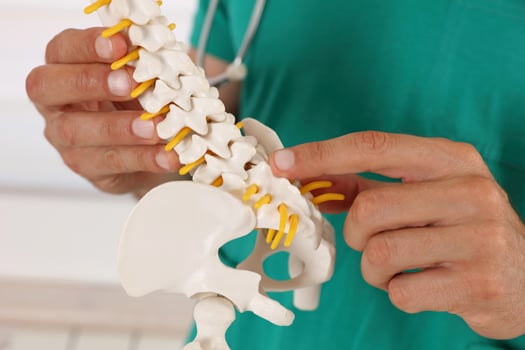
Some people have lumbar herniated discs and never know it. Other individuals immediately know something is wrong because of lower back pain that often includes discomfort extending to the lower body, especially the legs. This article discusses what a herniated disc in the lumbar spine area typically feels like.
Sciatica Symptoms Are Common
The nerve often affected by a herniated spinal disc in the lower back is the sciatic nerve, which starts at the base of the spine and works its way downward. If you have sciatica due to a herniated lumbar disc, you may feel the following:
• General lower back pain that is sometimes sharp
• Burning sensations
• Pain that feels like small electric shocks
• Pain that travels down one leg
• Numbness and tingling sensations
• Weakness in the legs
• Pain triggered by certain movements, such as going from a sitting to a standing position
More Strenuous Activities May Trigger Pain
Herniated lumbar spine discs tend to be more painful when bending, twisting, stretching, or making other strenuous movements. However, you may experience relief when resting on your back. If you do experience severe pain after making any of the above movements, take a break and try to avoid such motions. You may also benefit from a lumbar spine brace or support belt.
Muscle Spasms May Occur
The inflammation caused by a herniated spinal disc in the lower back area sometimes causes muscles to involuntarily contract. This is referred to as a muscle spasm, and it can be a source of sudden pain that is instantly noticeable. Applying heat or cold to the affected area is often an effective way to instantly ease muscle spasm pain. The heat increases circulation, which in turn helps muscle tissues heal and recover. Cold applications help by easing the inflammation associated with muscle spasms.
Leg and Foot Pain Are Possible
If your sciatic nerve is affected by a herniated spinal disc, the related pain may extend to your feet and ankles. This can happen as the sciatic nerve branches off into smaller nerve bundles. The problem here is that ankle and foot pain can make it difficult to walk and practically impossible to run or participate in certain sports-related activities. Additionally, your feet may drop or "fall asleep" due to the related nerve compression and irritation.
You May Need to Seek Immediate Medical Attention
You may also experience bowel or bladder issues due to the compression of the nerves that control these actions. If this occurs, seek immediate medical assistance. This is also necessary if your initial discomfort is extremely severe. Otherwise, many people with herniated lumbar discs benefit from nonsurgical treatments that include:
• Physical therapy
• Activity modifications
• Medication to control pain and inflammation
• Adjustments to posture or the correction of poor posture habits
If you have a herniated disc in your lower back that is not responding to conservative treatment, a lumbar discectomy may be discussed and potentially recommended. Although this is generally a very successful procedure, having a large hole in the outer ring of the disc more than doubles the risk of needing another operation. A new treatment, Barricaid, is a bone-anchored device that closes this hole, and 95 percent of Barricaid patients did not undergo a reoperation due to reherniation in a 2-year study time frame. This treatment is done immediately following the discectomy—during the same operation—and does not require any additional incisions or time in the hospital.
If you have any questions about the Barricaid treatment, ask your doctor or contact us at 844-288-7474.
For full benefit/risk information, please visit: https://www.barricaid.com/instructions.


Comments